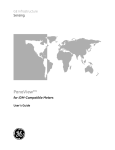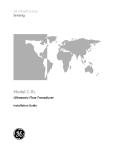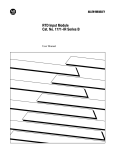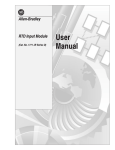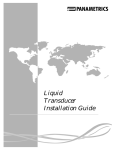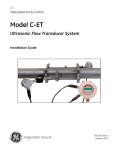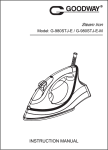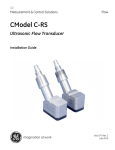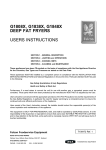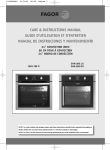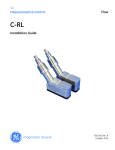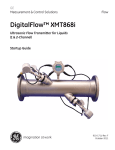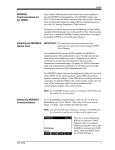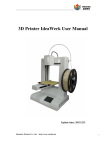Download GE Panametrics UTXDR Ultrasonic Flow Transducers
Transcript
GE Sensing & Inspection Technologies Model UTXDR Panametrics Ultrasonic Flow Transducer Installation Guide GE Sensing & Inspection Technologies Model UTXDR Panametrics Ultrasonic Flow Transducer Installation Guide 916-082A October 2008 October 2008 Warranty Each instrument manufactured by GE Sensing, Inc. is warranted to be free from defects in material and workmanship. Liability under this warranty is limited to restoring the instrument to normal operation or replacing the instrument, at the sole discretion of GE. Fuses and batteries are specifically excluded from any liability. This warranty is effective from the date of delivery to the original purchaser. If GE determines that the equipment was defective, the warranty period is: • one year for general electronic failures of the instrument • one year for mechanical failures of the sensor If GE determines that the equipment was damaged by misuse, improper installation, the use of unauthorized replacement parts, or operating conditions outside the guidelines specified by GE, the repairs are not covered under this warranty. The warranties set forth herein are exclusive and are in lieu of all other warranties whether statutory, express or implied (including warranties of merchantability and fitness for a particular purpose, and warranties arising from course of dealing or usage or trade). Return Policy If a GE Sensing, Inc. instrument malfunctions within the warranty period, the following procedure must be completed: 1. Notify GE, giving full details of the problem, and provide the model number and serial number of the instrument. If the nature of the problem indicates the need for factory service, GE will issue a RETURN AUTHORIZATION number (RA), and shipping instructions for the return of the instrument to a service center will be provided. 2. If GE instructs you to send your instrument to a service center, it must be shipped prepaid to the authorized repair station indicated in the shipping instructions. 3. Upon receipt, GE will evaluate the instrument to determine the cause of the malfunction. Then, one of the following courses of action will then be taken: • If the damage is covered under the terms of the warranty, the instrument will be repaired at no cost to the owner and returned. • If GE determines that the damage is not covered under the terms of the warranty, or if the warranty has expired, an estimate for the cost of the repairs at standard rates will be provided. Upon receipt of the owner’s approval to proceed, the instrument will be repaired and returned. iii October 2008 Table of Contents Introduction . . . . . . . . . . . . . . . . . . . . . . . . . . . . . . . . . . . . . . . . . . . . . . . . . . . . . . . . . . . . . . . . . . . . . . . . . . . . . . . . . 1 Preparing for Installation . . . . . . . . . . . . . . . . . . . . . . . . . . . . . . . . . . . . . . . . . . . . . . . . . . . . . . . . . . . . . . . . . . . . . 1 Choosing an Installation Location . . . . . . . . . . . . . . . . . . . . . . . . . . . . . . . . . . . . . . . . . . . . . . . . . . . . . . . . . 2 Preparing the Pipe. . . . . . . . . . . . . . . . . . . . . . . . . . . . . . . . . . . . . . . . . . . . . . . . . . . . . . . . . . . . . . . . . . . . . . . . 2 Obtaining Transducer Spacing . . . . . . . . . . . . . . . . . . . . . . . . . . . . . . . . . . . . . . . . . . . . . . . . . . . . . . . . . . . . 2 Setting Transducer Spacing . . . . . . . . . . . . . . . . . . . . . . . . . . . . . . . . . . . . . . . . . . . . . . . . . . . . . . . . . . . . . . . 3 Couplants. . . . . . . . . . . . . . . . . . . . . . . . . . . . . . . . . . . . . . . . . . . . . . . . . . . . . . . . . . . . . . . . . . . . . . . . . . . . . . . . 4 Installing the Transducers on the Pipe. . . . . . . . . . . . . . . . . . . . . . . . . . . . . . . . . . . . . . . . . . . . . . . . . . . . . . . . . 5 Using Velcro Straps. . . . . . . . . . . . . . . . . . . . . . . . . . . . . . . . . . . . . . . . . . . . . . . . . . . . . . . . . . . . . . . . . . . . . . . 5 Using Metal Pipe Clamps. . . . . . . . . . . . . . . . . . . . . . . . . . . . . . . . . . . . . . . . . . . . . . . . . . . . . . . . . . . . . . . . . 15 Maintaining the UTXDR Transducers . . . . . . . . . . . . . . . . . . . . . . . . . . . . . . . . . . . . . . . . . . . . . . . . . . . . . . . . . 19 Specifications. . . . . . . . . . . . . . . . . . . . . . . . . . . . . . . . . . . . . . . . . . . . . . . . . . . . . . . . . . . . . . . . . . . . . . . . . . . . . . . 20 v October 2008 Introduction The Model UTXDR clamp-on ultrasonic flow transducer for liquids is used exclusively with the GE Sensing line of ultrasonic flowmeters (see Table 1 below). These transducers measure the flow rate of sonically-conductive liquids through pipes having diameters from 0.5 in. (1.3 cm) to 8 in. (20.3 cm). Such measurements are typically independent of the pipe material. Figure 1 below shows a typical UTXDR transducer assembly. Table 1: UTXDR Application Information Flowmeter Model Cable Type Clamp Type UTX878 3C Metal DF868, XMT868 & AT868 2C Metal PT878 LM Velcro Figure 1: UTXDR Transducer Assembly Preparing for Installation Before the clamping fixture and transducers can be properly installed: • Choose an installation location. • Prepare the pipe. • Obtain the transducer spacing. Caution! A flowmeter’s accuracy and performance depends on the location, spacing, and alignment of the transducers. The transducer spacing is unique to your installation. Installing UTXDR Transducers 1 October 2008 Choosing an Installation Location Locate the transducer measurement point at least 3 ft (1 m) from any butt welds or flanges. Ideally the location would be in the center of a 20 ft (6 m) section of straight pipe. Make sure there is 6 in. (15 cm) clearance on both sides of the pipe for easy transducer installation. Note: To guarantee the specified accuracy of the flowmeter, a straight section of pipe and a fully-developed flow profile are highly recommended. However, if such conditions are not possible, the transducer location should be such that the acoustic signal travels through the full distribution of the under-developed flow profile for best repeatability. Preparing the Pipe To prepare the pipe for transducer installation, complete the following steps: 1. Remove any rust and paint from an area 2 in. (5 cm) wide by 12 in. (30 cm) long on one side of the pipe. 2. Polish the cleaned area, taking care to preserve the original curvature of the pipe. 3. With an ultrasonic thickness gage, measure the pipe thickness at a minimum of six spots on the cleared area. Take at least three measurements at each spot to ensure accuracy. The thickness readings should not vary by more than 5% at each spot. If you encounter more than a 5% variation at each spot, try a different section of the pipe. Verify that the wall thickness at both transducer locations has less than the 5% variation. 4. Measure the outside diameter (OD) of the pipe using a tape measure or the supplied pipe wrap. Obtaining Transducer Spacing Before installing the clamping fixture, you must obtain the transducer spacing from the flowmeter. You will need to know the transducer spacing later in this procedure. To obtain the spacing, you must enter the measured OD and the average pipe wall thickness into the flowmeter’s user program (Pipe Parameters) to determine the transducer spacing. Refer to your flowmeter User’s Manual or Startup Guide for more details, and for instructions on navigating to the programming screen for the transducer spacing. 2 Installing UTXDR Transducers October 2008 Setting Transducer Spacing Adjustment Screws Figure 2: The UTXDR Transducer Design To set the desired transducer spacing: 1. Loosen the red screws on the adjustable transducer (shown in Figure 2 above). 2. Slide the adjustable transducer on the rails until you have positioned it at the desired spacing. Use the ruler on the rails and the white tick mark on the transducer housing to assist in setting the correct spacing. 3. Tighten the red screws to secure the transducer to the rails. Installing UTXDR Transducers 3 October 2008 Couplants An ultrasonic couplant is supplied for your UTXDR installation. The purpose of the couplant is to provide reliable transmission of ultrasound between two adjacent solid surfaces. Generally speaking, couplants perform this task by excluding air from between the adjacent surfaces. Accordingly, the UTXDR transducers should be pressed tightly against the pipe to squeeze the couplant to as thin a film as practical for the given pipe surface. The most commonly used couplants in ultrasonic testing are ordinarily satisfactory for any short-term clamp-on flowmeter application. These couplants include, in general order of preference: gels, grease, propylene glycol, oil, glycerine, and water. Long-term couplants include grease, epoxy adhesive, and solid rubber-like sheet couplant. The factory provides couplants for both permanent and temporary use as well as for high- and low-temperature applications. For long-term installations, make sure the couplant does not dry or run out. Standard couplants supplied by GE are listed in Table 2 below. Table 2: Couplants PART NO. CPL-1 TYPE Standard TEMP. RANGE CPL-2 High/Low Temperature -256 to 500oF (-160 to +260oC) Semi-Permanent CPL-3 For Portable Temporary CPL-4 Special -4 to 140oF (-20 to +60oC) As Required CPL-7 Epoxy o -40 to 149 F (-40 to +65oC) 14 to 122oF (-10 to +50oC) USE Semi-Permanent *Difficult Applications Permanent Permanent -40 to 446oF (-40 to +230oC) * Installations involving hotter or colder temperatures than listed above, may require special couplants. Consult the factory for such applications. CPL-8 4 Solid Sheet Installing UTXDR Transducers October 2008 Installing the Transducers on the Pipe Using Velcro Straps Proceed to the appropriate section for your transducers: • Velcro straps - below • Metal clamps - page 15 If your transducers are supplied with velcro straps, follow the instructions in this section. Figure 3: Clamping Fixture with Loose Straps 1. Use an allen wrench to loosen the set screws on each side of one of the housings and slide one of the rails forward (see Figure 4 below). Figure 4: Loosening the Set Screws Installing UTXDR Transducers 5 October 2008 Using Velcro Straps (cont.) 2. Slip the looped end of the strap into the slot area. Be sure the hook and pile side is facing upwards (see Figure 5 below). Figure 5: Inserting the Velcro Strap 3. Slide the rail through the looped end of the strap and continue until the end of the rail is flush with the back edge of the housing (see Figure 6 below). This is critical for proper measurements off of the markings on the rails. Figure 6: Sliding the Rail through the Looped End of the Strap 6 Installing UTXDR Transducers October 2008 Using Velcro Straps (cont.) 4. Repeat the previous step on the other housing by loosening both thumb screws and sliding the housing back (see Figure 7 below). Again, remember to keep the hook and pile side facing upwards. Figure 7: Sliding the Other Rail through the Strap The straps are now secure. Figure 8: Secure Straps Installing UTXDR Transducers 7 October 2008 Using Velcro Straps (cont.) 5. For installation on small diameter pipes (1½” and smaller), slip the straps through the inner slot closest to the strap (see Figure 9 below). Figure 9: Installation on Small Diameter Pipes Figure 10 below is a view of the underside of the clamping fixture with the straps through the inner slots. Figure 10: Clamping Fixture Underside 8 Installing UTXDR Transducers October 2008 Using Velcro Straps (cont.) 6. Apply the supplied couplant to the transducer faces, as shown in Figure 11 below. Figure 11: Transducer Faces 7. Position the clamping fixture on the pipe and slip the strap around the bottom of the pipe and up through the other inner slot towards the inside of the second rail (see Figure 12 below). Figure 12: Positioning the Clamping Fixture on the Pipe Installing UTXDR Transducers 9 October 2008 Using Velcro Straps (cont.) 8. Flip the strap over the top of the rail and pull taught. Figure 13: Tightening the Strap 9. Bring the strap back around the bottom of the pipe and secure the strap to itself. Be sure the strap remains taught as it is secured to firmly hold the clamping fixture on the pipe. Figure 14: Securing the Strap to Itself 10 Installing UTXDR Transducers October 2008 Using Velcro Straps (cont.) 10.Repeat Steps 7, 8 and 9 on the other half of the clamping fixture. Figure 15: Securing the Other Half The straps are now secure. Figure 16: Secure Straps Installing UTXDR Transducers 11 October 2008 Using Velcro Straps (cont.) Figure 17 below shows a view of the underside of the clamping fixture. Figure 17: Clamping Fixture Underside The straps can be tidied up by wrapping them around the fixture several times and ending with a half twist, followed by a single wrap around, and then another half twist so that the strap can again be attached to itself. Figure 18: Tidying Up the Straps 12 Installing UTXDR Transducers October 2008 Using Velcro Straps (cont.) For larger diameter pipes, the strap does not pass through the inner slot, but simply passes around the bottom of the pipe. Then it slips under, around and over the other rail. Figure 19: Wrapping the Strap on Larger Diameter Pipes The strap then wraps around the bottom of the pipe again and secures back onto itself. Figure 20: Securing the Strap on Larger Diameter Pipes Installing UTXDR Transducers 13 October 2008 Using Velcro Straps (cont.) Again, the straps can be tidied up. Figure 21: Tidying Up the Straps Once on the pipe, an internal spring mechanism ensures proper mechanical pressure by “pressing” the transducer face against the pipe surface. Note: Refer to your flowmeter User’s Manual or Startup Guide to wire the transducers. 14 Installing UTXDR Transducers October 2008 Using Metal Pipe Clamps If your transducers were supplied with metal pipe clamps, follow the instructions in this section. The smaller pipe clamps are used for smaller diameter pipes. Figure 22: Using Metal Pipe Clamps 1. Apply the supplied couplant to the transducer faces, as shown in Figure 11 below. Figure 23: Transducer Faces Installing UTXDR Transducers 15 October 2008 Using Metal Pipe Clamps (cont.) 2. Pass the pipe clamps through the inner slots. Figure 24: Metal Pipe Clamps Through the Inner Slots 3. Affix the pipe clamps around the pipe. Figure 25: Metal Pipe Clamps Around the Pipe 16 Installing UTXDR Transducers October 2008 Using Metal Pipe Clamps (cont.) Note: Use of a temporary clamp facilitates installation. 4. Use a nut driver to tighten the pipe clamps (see Figure 26 below). Figure 26: Tightening the Metal Pipe Clamps 5. Fully secure the clamping fixture to the pipe. Figure 27: Clamping Fixture Secured to the Pipe Installing UTXDR Transducers 17 October 2008 Using Metal Pipe Clamps (cont.) Figure 28: Another View Note: Larger pipe clamps can also be used for larger diameter pipes, and they would not go through the inner slots, but simply pass through the main slot of each housing. Once on the pipe, an internal spring mechanism ensures proper mechanical pressure by “pressing” the transducer face against the pipe surface. Note: Refer to your flowmeter User’s Manual or Startup Guide to wire the transducers. 18 Installing UTXDR Transducers October 2008 Maintaining the UTXDR Transducers Transducers, couplant, and the clamping fixture are provided by the factory. Once you have completed the installation, little maintenance is required. Refer to Table 3 below for maintenance information. Table 3: Maintenance Checks Component Transducer Couplant Interval Maintenance Check Comments N/A No additional adjustments or maintenance is needed. If you suspect something is wrong with a transducer and/or you need to replace it, simply remove the clamps that secure the transducer assembly in place and remove it. Refer to Installing the Transducers on the Pipe on page 5 to insert a new transducer. No cleaning is required. Verify every 6 months in Measure the signal strength using the flowmeter diagnostics and compare it to the value taken at dry areas the time of installation. Good and bad limits are (e.g. the desert). Verify every 12 months listed in the flowmeter User’s Manual. No cleaning is required. in other areas. Clamping Fixture Determined by user Installing UTXDR Transducers Periodic inspection and tightening of the clamping fixture nuts is required to ensure the clamping fixture does not become loose and fall from the pipe, possibly causing injury. No cleaning is required. 19 October 2008 Specifications Table 4: UTXDR Transducer Specifications Parameter Transducer # 407 408 Intended Uses Small pipes; High performance Installation Type Clamp-on for liquid applications Material 316 Stainless Steel, aluminum and plastic Pipe Sizes 2” to 8” (5 to 20 cm) 0.5” to 2” (1 to 5 cm) diameter diameter Operating Frequency 2 MHz 4 MHz Electrical Rating 200 V peak-to-peak, 5 mA Ambient Temperature Range –4° to 140°F (–20° to 60°C) Process Temperature Range –4° to 140°F (–20° to 60°C) North American Certification - Weatherproof European Certification - Weatherproof IP65, Type NEMA 4 IP65 IMPORTANT: The transducer is protected by a suitable fuse located in the flowmeter electronics. The fuse has a breaking capacity in accordance with the short circuit current of the supply. 20 Installing UTXDR Transducers USA 1100 Technology Park Drive Billerica, MA 01821-4111 Web: www.gesensing.com Ireland Sensing House Shannon Free Zone East Shannon, County Clare

























